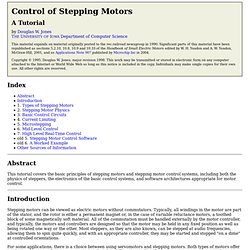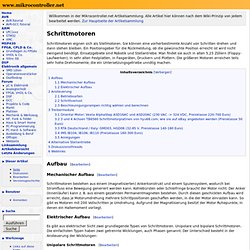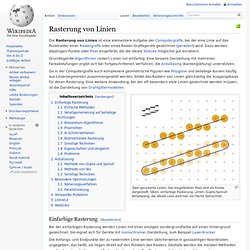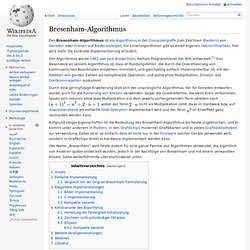

Jones on Stepping Motors. Index Abstract This tutorial covers the basic principles of stepping motors and stepping motor control systems, including both the physics of steppers, the electronics of the basic control systems, and software architectures appropriate for motor control.

Introduction Stepping motors can be viewed as electric motors without commutators. Typically, all windings in the motor are part of the stator, and the rotor is either a permanent magnet or, in the case of variable reluctance motors, a toothed block of some magnetically soft material. For some applications, there is a choice between using servomotors and stepping motors. In making a choice between steppers and servos, a number of issues must be considered; which of these will matter depends on the application. Stepping motors are known in German as Schrittmotoren, in French as moteurs pas à pas, and in Spanish as motor paso a paso. Other Sources of Information Web Sites. Schrittmotoren. Schrittmotoren eignen sich als Stellmotoren.

Sie können eine vorherbestimmte Anzahl von Schritten drehen und dann stehen bleiben. Schrittmotoren. Aus RN-Wissen, der freien Wissensdatenbank Was ist ein Schrittmotor Schrittmotoren arbeiten völlig anders als Gleichstrommotoren.

Das ist schon daran zu erkennen, dass diese keine zwei, sondern meist 4, 6 oder 8 Anschlüsse (bipolare oder unipolare Motoren) besitzen. Demzufolge ist es also nicht damit getan, irgendwo Spannung anzulegen, um den Motor zum Drehen zu bewegen. Aber keine Sorge, sehr kompliziert ist es dennoch nicht. Ein Schrittmotor (oft auch Stepper genannt) ist ein Synchronmotor, bei dem der Rotor (drehbares Motorteil mit der Welle) bei geschickter Wahl der angesteuerten Statorspulen (nichtdrehbarer Motorteil) gezielt um einen Winkel gedreht werden kann. Wie unterscheidet man Schrittmotoren Man unterscheidet den Schrittmotor nach seiner Bauform in Reluktanzmotor und Permanentmagnetmotor, wobei man beide Formen auch zu einem Hybridschrittmotor kombinieren kann. Schrittmotoren existieren auch in Form von Linearmotoren.
Allegro Motor Drivers. Allegro offers an industry leading portfolio of motor driver and controller ICs for brushless DC, brush DC, and stepper motors.

Product architectures vary from highly-efficient internal DMOS drivers to MOSFET controller ICs suited for a wide variety of motor applications. Coupled with a strong system level expertise, Allegro’s motor driver IC portfolio provides the user with a high-performance, leading edge and reliable motor control solution. Allegro's BCD (bipolar, CMOS and DMOS components) technology allows for a wide range of features that is well suited for today’s demanding motor control applications. Allegro motor driver ICs can be found in a number of demanding markets, including automotive, industrial and office equipment. Our products are found in motor driver applications such as automotive pumps and blowers, electronic power steering (EPS) systems, printers (ink-jet and laser) and a variety of cooling fan applications.
ST L6219. AVR Application Notes. AVR Motor Applications. Get Started We'll tell you all you need to know to start evaluating and working with this product.

Atmel® has more than 15 years' experience with driver ICs for DC motors. We supply products at a high-volume for a variety of common body electronic applications, including mirror control and flap control in HVACs. Although the Atmel driver ICs are equipped with a variety of types of driver stages, they all share the same protection features – short-circuit protection, temperature warning and switch off, low voltage protection, and open load detection – all of which are a must for automotive electronics. Features and Benefits The continuously growing Atmel driver family includes a wide variety of combinations of integrated high-side and low-side output stages, enabling designers to easily tailor solutions to their needs.Our driver portfolio includes ICs for small DC motors controlled directly from the output stages. Atmel Products. Anpassung AVR446 auf GCC (Schrittmotorsteuerung)
Article - Generate stepper-motor speed profiles in real time. Source Code - Motor.c. AVR freaks - Stepper Motor Controller with ACC and DEC. #ifdef __iom64v_h #define UART1_TRANSMIT_ON() UCSR1B |= 0x08 #define UART1_TRANSMIT_OFF() UCSR1B &= ~0x08 #define UART1_RECEIVE_ON() UCSR1B |= 0x10 #define UART1_RECEIVE_OFF() UCSR1B &= ~0x10 #endif __iom64v_h // This program was written by Carl W Livingston, KC5OTL. // I freely grant permission to use this program for personal use only. // No commercial use of this program is allowed unless written authorization // is granted by the author, Carl W.

Livingston, KC5OTL. // If changes are made to this program, due credit must be given to the // original author, Carl W. Livingston, KC5OTL. // While this program may migrate to the global public domain, this program // was written for my personal use and is released to www.AVRFreaks.net for // the personal use of the members of www.AVRFreaks.net. /********************************************************************************* // DISCLAIMER!!! The program was written using the ImageCraft ICCAVR V7.xx C complier. Cmd = NULL; OpenServo. Rasterung von Linien. Da in der Computergrafik auch komplexere geometrische Figuren wie Polygone und beliebige Kurven häufig aus Liniensegmenten zusammengesetzt werden, bildet das Rastern von Linien gleichzeitig die Ausgangsbasis für deren Rasterung.

Eine weitere Anwendung, bei der oft besonders viele Linien gezeichnet werden müssen, ist die Darstellung von Drahtgittermodellen. Zwei gerasterte Linien. Die eingefärbten Pixel sind als Kreise dargestellt. Oben: einfarbige Rasterung; unten: Gupta-Sproull-Antialiasing, die ideale Linie wird hier als Fläche betrachtet.
Einfarbige Rasterung[Bearbeiten] Bei der einfarbigen Rasterung werden Linien mit einer einzigen Vordergrundfarbe auf einen Hintergrund gezeichnet. Einfache Methoden[Bearbeiten] Naive Methode der Rasterung mittels Rundung. Newline. Bresenham-Algorithmus. Der Algorithmus wurde 1962 von Jack Bresenham, damals Programmierer bei IBM, entwickelt.[1] Das Besondere an seinem Algorithmus ist, dass er Rundungsfehler, die durch die Diskretisierung von kontinuierlichen Koordinaten entstehen, minimiert, und gleichzeitig einfach implementierbar ist, mit der Addition von ganzen Zahlen als komplexeste Operation, und somit ohne Multiplikation, Division und Gleitkommazahlen auskommt.

Durch eine geringfügige Erweiterung lässt sich der ursprüngliche Algorithmus, der für Geraden entworfen wurde, auch für die Rasterung von Kreisen verwenden. Sogar die Quadratterme, die beim Kreis vorkommen, lassen sich rekursiv ohne jede Multiplikation aus dem jeweils vorhergehenden Term ableiten nach , wobei der Term nicht als Multiplikation zählt, da er in Hardware bzw. auf Assemblerebene als einfache Shift-Operation implementiert wird und der Term im Endeffekt ganz vermieden werden kann.
Ansatz[Bearbeiten] nach. AccelStepper library for Arduino. Adafruit/AccelStepper.